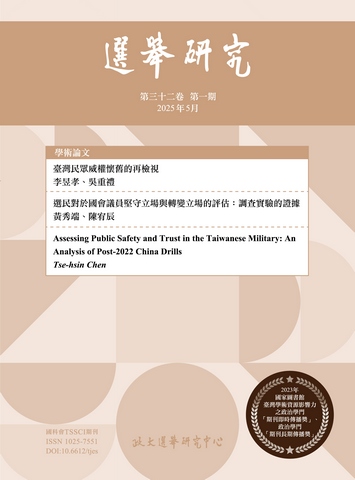 |
 本站僅提供期刊文獻檢索。 本站僅提供期刊文獻檢索。
【月旦知識庫】是否收錄該篇全文,敬請【登入】查詢為準。
 最新【購點活動】 最新【購點活動】
|
| 篇名 |
選舉制度與憲政體制的制度組合:半總統制民主國家的跨國分析
|
| 並列篇名 |
The Combination of Electoral System and Constitutional System: A Cross-Country Study of Semi-Presidential Democracies |
| 作者 |
蘇子喬、王業立 |
| 中文摘要 |
本文以「國會選舉制度」、「國會政黨體系」、「憲政體制(半總統制)」、「政府型態」等變項所構成的分析架構為基礎,探討全世界民主國家在不同半總統制次類型(總理總統制與總統議會制)與各種主要國會選舉制度(單一選區相對多數制、比例代表制、聯立制、並立制)組合下的憲政運作差異。本文發現:在半總統制的兩種次類型中,總理總統制無論是與哪一種國會選舉制度組合,其憲政運作整體而言會比總統議會制與各種國會選舉制度的組合來得順暢。此一發現,可以為學界中關於「總理總統制優於總統議會制」的一般觀點提供另一項支持的立論基礎。再者,就總統議會制而言,這種半總統制次類型與單一選區相對多數制(或並立制)組合下的憲政運作,有時會比其與比例代表制(或聯立制)組合下的憲政運作顯得更為順暢,但有時卻又顯得更為窒礙難行。這種現象顯示了總統議會制下的選制選擇容易陷入難以取捨的兩難困境。此外,本文也對全世界半總統制民主國家採行總統選舉制度的整體趨勢進行觀察,指出兩項一般常見的直覺觀點:一是以為總統選舉制度類型與總統憲法權力大小存在著關聯性,二是以為相對多數制的總統選舉制度相較於兩輪決選制,傾向選出民意基礎較薄弱的總統,這兩項與實際經驗並不相符的一般直覺觀點實有必要破除。
With an analytical framework comprised of variables such as parliamentary electoral system, political party system in the parliament, constitutional system (semi-presidentialism) and government type, this paper explores the differences among the constitutional operations from different combinations of the semi-presidentialism subtype (premier presidentialism and president parliamentarism) and the parliamentary electoral system (plurality with single-member-district system, proportional representation system, mixed-member proportional system and mixed-member majoritarian system) in the democracies all over the world. As far as semi-presidentialism is concerned, it is found that the overall constitutional operation under premier presidentialism, no matter which parliamentary electoral system is adopted, goes better than that under president parliamentarism. This finding can be another supportive reference for the perspective which believes premier presidentialism is better than president parliamentarism. Furthermore, the constitutional operation under the combination of president parliamentarism and plurality with a single-member-district system (or mixed-member majoritarian system) is sometimes proceeds more smoothly than that under the combination of president parliamentarism and proportional representation system (or mixed-member proportional system), but sometimes it does not, and even becomes more obstructed. This shows the dilemma of how to choose a suitable parliamentary electoral system under president parliamentarism. Besides, this paper also observes the overall tendency of semi-presidential democracies' choices for the presidential electoral system, and points out two common misconceptions. The first is the belief that whether the president has great constitutional powers or not is related to the presidential electoral system, and the second is the belief that the president elected via a plurality system has less democratic legitimacy than the president elected via a majority system. These two perspectives do not correspond to actual experiences, and should be clarified. |
| 英文摘要 |
With an analytical framework comprised of variables such as parliamentary electoral system, political party system in the parliament, constitutional system (semi-presidentialism) and government type, this paper explores the differences among the constitutional operations from different combinations of the semi-presidentialism subtype (premier presidentialism and president parliamentarism) and the parliamentary electoral system (plurality with single-member-district system, proportional representation system, mixed-member proportional system and mixed-member majoritarian system) in the democracies all over the world. As far as semi-presidentialism is concerned, it is found that the overall constitutional operation under premier presidentialism, no matter which parliamentary electoral system is adopted, goes better than that under president parliamentarism. This finding can be another supportive reference for the perspective which believes premier presidentialism is better than president parliamentarism. Furthermore, the constitutional operation under the combination of president parliamentarism and plurality with a single-member-district system (or mixed-member majoritarian system) is sometimes proceeds more smoothly than that under the combination of president parliamentarism and proportional representation system (or mixed-member proportional system), but sometimes it does not, and even becomes more obstructed. This shows the dilemma of how to choose a suitable parliamentary electoral system under president parliamentarism. Besides, this paper also observes the overall tendency of semi-presidential democracies' choices for the presidential electoral system, and points out two common misconceptions. The first is the belief that whether the president has great constitutional powers or not is related to the presidential electoral system, and the second is the belief that the president elected via a plurality system has less democratic legitimacy than the president elected via a majority system. These two perspectives do not correspond to actual experiences, and should be clarified. |
| 起訖頁 |
1-36 |
| 關鍵詞 |
國會選舉制度、總統選舉制度、半總統制、總理總統制、總統 議會制、parliamentary electoral system、presidential electoral system、semi-presidentialism、premier presidentialism、president parliamentarism |
| 刊名 |
選舉研究 |
| 期數 |
201805 (25:1期) |
| 出版單位 |
政大出版社;國立政治大學選舉研究中心
|
| 該期刊-下一篇 |
問卷調查題型設計的效應檢證:以「政治知識」測量的隨機實驗為例 |
| |
|
新書閱讀
最新影音
優惠活動
|

